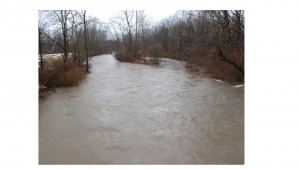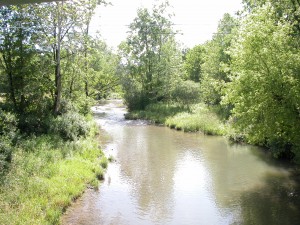Issue:
Almost every water body is naturally dynamic, with alternating periods of high and low water levels or flows. These patterns are not random, but rather follow predictable cycles, driven by regional climates, landscape features, and other factors. Given the dramatically different physical conditions associated with flooding versus drawdown, plants and other organisms have evolved and become adapted to, and even dependent upon, these predictable patterns. For example, many fish, invertebrates, and plants time the release of eggs / seeds with the onset of higher flows in order to access the resources made available in newly flooded habitats.This process occurs both in flowing waters of streams and rivers, and is also associated with water level fluctuations along shorelines of lakes and ponds.
 Typical water level change in a northeastern stream from low flow in August to high flow during late winter snowmelt
Typical water level change in a northeastern stream from low flow in August to high flow during late winter snowmelt
(viewed from same spot on bridge).
Human activities have altered the natural hydrologic regime of water bodies throughout much of the world. Hydropower dam operations routinely stop and start the river’s flow on a daily basis to maximize electricity generation. Flood control dams successfully stabilize river flow regimes, reducing the timing and magnitude of peak flows, viewed as floods, and elevating baseline flow conditions. Changes in watershed hydrologic features, such as increasing the extent of impervious surfaces and augmenting natural drainage networks, accelerate stormwater runoff, contributing both to floods and stream dryouts. Water levels in many northern lakes are routinely lowered each fall to prevent ice scour from damaging docks and to provide a reservoir to capture spring snowmelt water.
We need to consider protecting or mimicking these environmental flows, also known as “the natural hydrologic flow regime” (Poff et al. 1997), in order to support sustainable ecosystems.
Researching the ecosystem processes associated with Environmental Flows:
Rivers:
- Schneider, R.L. and R.R. Sharitz. 1988. Hydrochory and regeneration of a bald cypress-water tupelo swamp forest. Ecology 69: 1055-1062.
- Schneider, R.L. and R.R. Sharitz. 1986. Seed bank dynamics in a southeastern riverine swamp. American Journal of Botany 73(7): 1022-1033.
- Schneider, R.L., N. E. Martin, and R.R. Sharitz. 1989. Impact of dam operations on hydrology and associated floodplain forests of southeastern rivers. pp. 1113-1122. IN: R.R. Sharitz and J.W.Gibbons. Freshwater wetlands and wildlife. Proceedings of a symposium held at Charleston, South Carolina, March 24-27, 1986. U.S. National Technical information Service DE90005384.
- Jones, R.H., R.R. Sharitz, P.M. Dixon, D.S.Segal, and R.L.Schneider. 1994. Woody plant regeneration in four floodplain forests. Ecological Monographs 64(3): 345-367.
Lakes and Ponds:
- Schneider, R.L. 1994. The role of hydrologic regime in maintaining rare plant communities of New York’s coastal plain pondshores. Biological Conservation. 68: 253-260.
- Schneider, R.L., M.S. Mayer, and T.C. Hall. 2016. Watershed, climate, and lake level manipulations. pp. 53-70 IN: L.G. Rudstam, E.L. Mills, J.r. Jackson, and D.J.Stewart. eds. Oneida Lake; long-term dynamics of a managed ecosystem and its fishery. American Fisheries Society, Bethesda, MD. ISBN 978-1-934874-43-1

